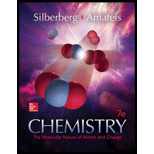
(a)
Interpretation:
The Lewis structure of
Concept introduction:
The Lewis structures are the diagrams that are used to show the bonding between various atoms in a covalent molecule and the number of lone pairs present in that molecule. These are also known as Lewis dot diagrams, electron dot diagrams, Lewis dot structures or Lewis dot formula. These are used to predict the geometry, polarity, and reactivity of covalent compounds.
(b)
Interpretation:
The change in electron-group arrangement, molecular shape and hybridization of nitrogen when hydrazine reacts to form the given product is to be determined.
Concept introduction:
Hybridization is the process of intermixing of atomic orbital of slightly different energies to form hybrid orbitals that have similar energy. These orbital have lower energy and more stability than the atomic orbital.
The molecular shape is the three-dimensional arrangement of atoms in the molecule. It depends on the bond pairs as well as lone pairs. The electron-group arrangement tells about the distribution of electrons around the various atoms in the molecule.
(c)
Interpretation:
The change in electron-group arrangement, molecular shape and hybridization of carbon when carbon disulfide reacts to form the given product is to be determined.
Concept introduction:
Hybridization is the process of intermixing of atomic orbital of slightly different energies to form hybrid orbital that has similar energy. These orbital have lower energy and more stability than the atomic orbital.
The molecular shape is the three-dimensional arrangement of atoms in the molecule. It depends on the bond pairs as well as lone pairs. The electron-group arrangement tells about the distribution of electrons around the various atoms in the molecule.
Trending nowThis is a popular solution!

Chapter 11 Solutions
Chemistry: The Molecular Nature of Matter and Change - Standalone book
- help 20arrow_forwardProvide the drawing of the unknown structure that corresponds with this data.arrow_forward20.44 The Diels-Alder reaction is not limited to making six-membered rings with only car- bon atoms. Predict the products of the following reactions that produce rings with atoms other than carbon in them. OCCH OCCH H (b) CH C(CH₂)s COOCH མ་ནས་བ (c) N=C H -0.X- (e) H C=N COOCHS + CH2=CHCH₂ →→arrow_forward
- 3) Draw a detailed mechanism and predict the product of the reaction shown? 1) EtMgBr 2) H3O+arrow_forwardHow to draw the mechanism for this reaction?arrow_forward> H₂C=C-CH2-CH3 B. H₂O Pt C. + H2 + H₂O H D. 16. Give the IUPAC name for each of the following: B. Cl Cl c. Cl Cl 17. Draw the line-angle formula for each of the following compounds: 1. phenol 2. 1,3-dichlorobenzene 3. 4-ethyltoluene < Previous Submit Assignment Next ▸arrow_forward
 ChemistryChemistryISBN:9781305957404Author:Steven S. Zumdahl, Susan A. Zumdahl, Donald J. DeCostePublisher:Cengage Learning
ChemistryChemistryISBN:9781305957404Author:Steven S. Zumdahl, Susan A. Zumdahl, Donald J. DeCostePublisher:Cengage Learning ChemistryChemistryISBN:9781259911156Author:Raymond Chang Dr., Jason Overby ProfessorPublisher:McGraw-Hill Education
ChemistryChemistryISBN:9781259911156Author:Raymond Chang Dr., Jason Overby ProfessorPublisher:McGraw-Hill Education Principles of Instrumental AnalysisChemistryISBN:9781305577213Author:Douglas A. Skoog, F. James Holler, Stanley R. CrouchPublisher:Cengage Learning
Principles of Instrumental AnalysisChemistryISBN:9781305577213Author:Douglas A. Skoog, F. James Holler, Stanley R. CrouchPublisher:Cengage Learning Organic ChemistryChemistryISBN:9780078021558Author:Janice Gorzynski Smith Dr.Publisher:McGraw-Hill Education
Organic ChemistryChemistryISBN:9780078021558Author:Janice Gorzynski Smith Dr.Publisher:McGraw-Hill Education Chemistry: Principles and ReactionsChemistryISBN:9781305079373Author:William L. Masterton, Cecile N. HurleyPublisher:Cengage Learning
Chemistry: Principles and ReactionsChemistryISBN:9781305079373Author:William L. Masterton, Cecile N. HurleyPublisher:Cengage Learning Elementary Principles of Chemical Processes, Bind...ChemistryISBN:9781118431221Author:Richard M. Felder, Ronald W. Rousseau, Lisa G. BullardPublisher:WILEY
Elementary Principles of Chemical Processes, Bind...ChemistryISBN:9781118431221Author:Richard M. Felder, Ronald W. Rousseau, Lisa G. BullardPublisher:WILEY





